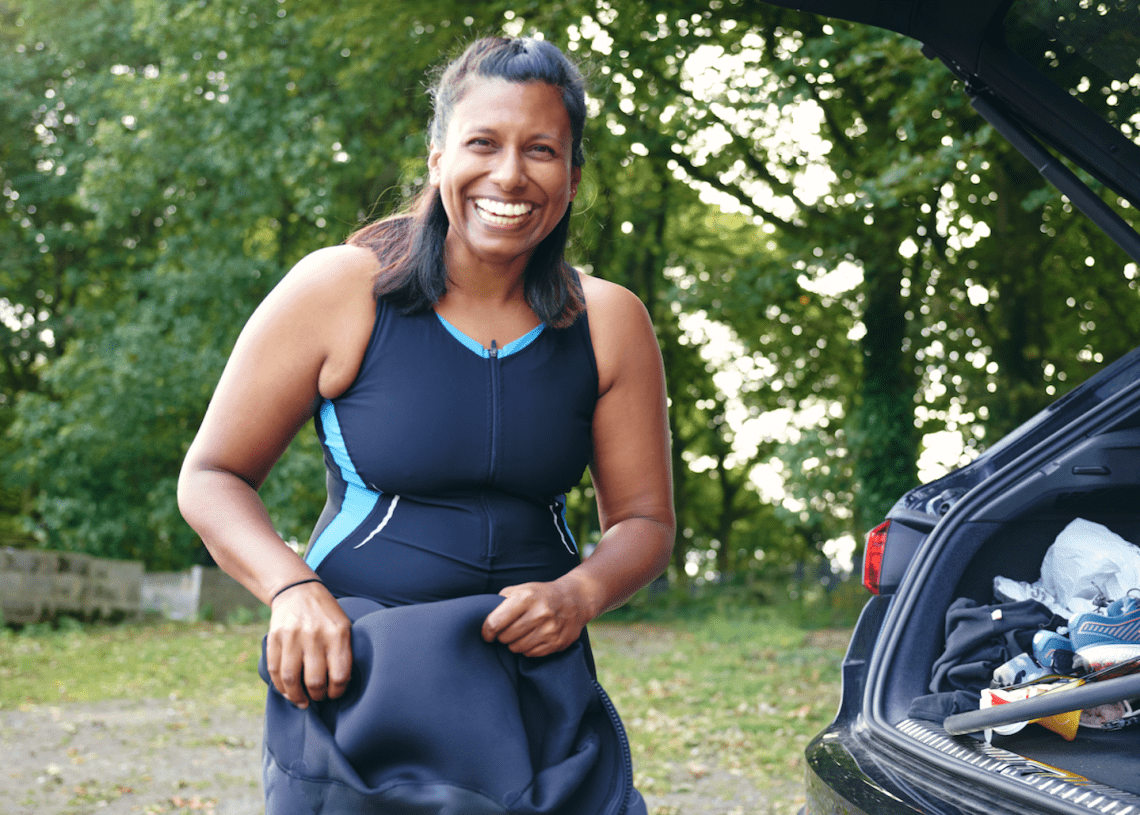
How do I transition from a swimsuit to a wetsuit?
Reader Jenny Knights is new to outdoor swimming and has her first open water next month. Swimming coach Cassie Patten shares her tips for swimming in a wetsuit and how to occupy your mind during a long swim
“I am new to open water swimming, but I have swum in the pool for many years and feel confident I will love the outdoors. I have a big birthday coming up so I have set myself a series of adventures, one of them being a 5km swim in late May. I am planning on wearing a wetsuit.
My questions to you are, how do you keep your mind focused on a long swim and what do you think about? Also, are there any areas to focus on when transitioning from a swimming costume to a wetsuit?” Jenny Knights
Hello Jenny, thank you for your questions. I am excited for you to start on your open water swimming adventure, but I must warn you that it is contagious and I have a feeling that you will fall in love with it!
Let’s get started with the difference between swimming in a costume and a wetsuit. This is a great question. The biggest differences are the lack of flexibility at the shoulders while wearing a wetsuit and the change in your buoyancy in the water due to the neoprene.
The fact that your shoulders will find it harder to move as freely means that you must ensure your rotation through the body is firmly at 45 degrees each side. This opens up the angle at the shoulder to around 130 degrees, allowing your arm to recover with ease. If you’re swimming flatter and your rotation is less there is more pressure going through the shoulder joints, which is exacerbated by the construction of the neoprene.
Take your time
If the wetsuit is not fitted correctly you will find that your triceps will fatigue at a quicker rate. This is because they are always fighting against the constriction of the wetsuit material. It should take a good five to ten minutes to put on a wetsuit correctly, anything less than that and you run the risk of having to fight against the wetsuit while swimming.
Start by pulling the wetsuit up to your hips. I always pull the bottom of the leg to around a quarter of the way up my shinbone, this allows for extra material to be around your groin area (you can always pull it down again afterwards if it is too high). By doing this you allow the wetsuit to have extra material and therefore more flexibility through your torso, as it is not stuck too far down your legs.
Then place both arms through the sleeves, again allowing a gap between the bottom of the arm and the wrist. Gently pinch the material up your arm, starting at the bottom and edging towards your shoulders, so you have a generous amount of material around your shoulder area.
Make adjustments
After zipping yourself in, get someone to pinch the material up your back either side of the zip so you have as much flexibility and material around your shoulder as possible. If afterwards you feel it’s too much you can gently edge some of it back down towards either your wrists or your ankles. It is better to have that full range of movement at the shoulder joint.
The buoyancy of a wetsuit changes your body position so that you sit higher in the water. If you have a strong leg kick I would recommend you look for a wetsuit with less buoyancy so you sit lower in the water and don’t run the risk of continuously kicking into the air. However, if you have ‘sinky legs’ you may wish to buy a wetsuit with more buoyancy.
Occupy your mind while swimming
Finally, what should you think about while swimming? Some people like to switch off completely and just be consumed by the feeling of the water and the sights around them. Other people like to have a plan of action when swimming a longer distance. I always had a strategy for my races.
For a 5km I would break the race into five lots of 1km. This helps you to get over the fact you’re going to be swimming for quite a long time, and also gives you a new focus every half an hour or so.
The first kilometre should be about getting into a lovely rhythm and thinking about your sighting and technique after the initial shot of adrenaline at the start.
During the second kilometre think about upping the pace and focus on a specific point of your technique, for example ensuring your rotation stays consistent.
The third kilometre is the midpoint; this is where people start thinking ‘oh goodness I’ve got to do this all again!’ Don’t panic and instead hold the pace you set yourself in the second kilometre and really enjoy this midpoint of the swim.
Kilometre four you need to put your foot down again on the gas a fraction. Think about lengthening your stroke and enjoying being in the water as the last kilometre is all about swimming for the finish.
To pass the time I used to sing songs in my head, normally with the wrong lyrics! But it was a nice way of passing a few minutes by humming my favourite tunes.
I really hope you enjoy your introduction to open water and please do let me know how you get on later this year.
This article is from the April 2023 issue of Outdoor Swimmer. Click here to subscribe to the magazine.
Browse more of our training pages.
To see all the online content from the April 2023 issue of Outdoor Swimmer, visit the 'Underwater' page.







